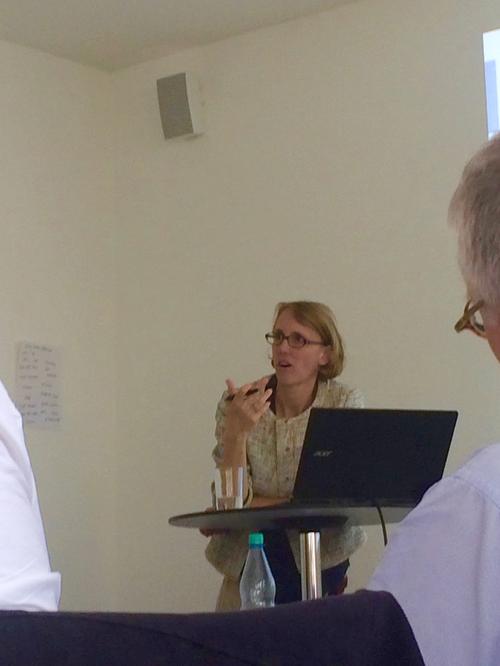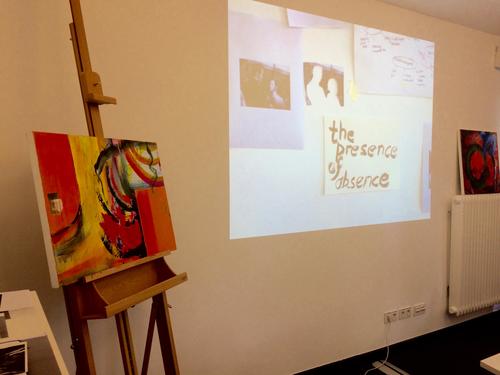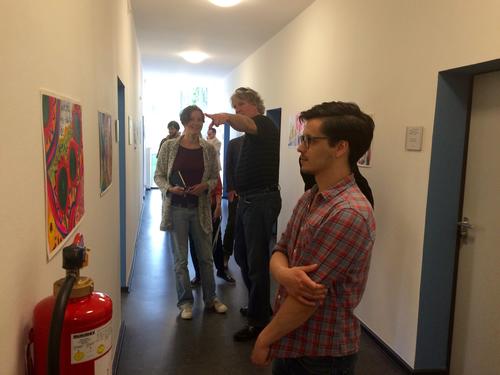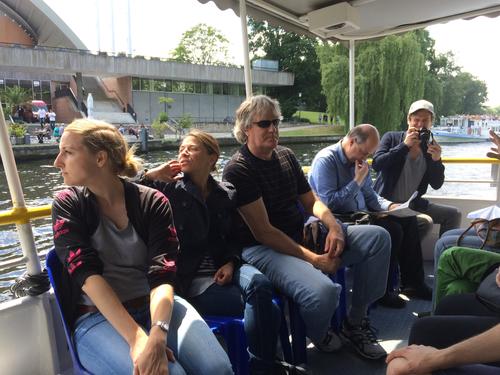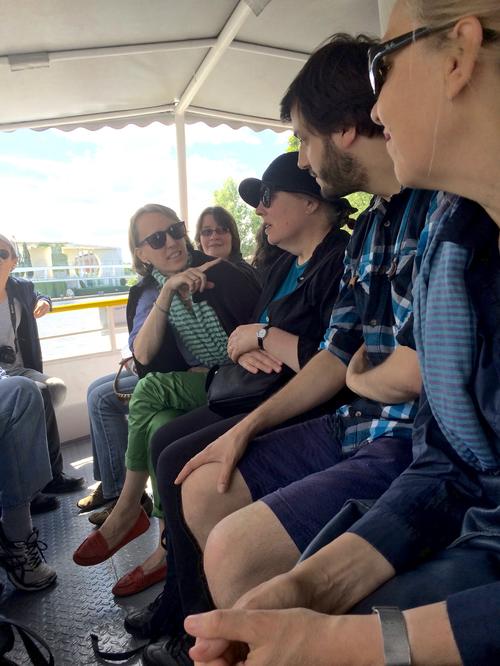Metaphor in Film and Literature
08. – 10.06.2016 | Workshop der Kolleg-Forschungsgruppe Cinepoetics mit Christina Schmitt (Berlin), Lynne Cameron (London), Charles Forceville (Amsterdam), Warren Buckland (Oxford), Kathrin Fahlenbrach (Hamburg) und Oliver Lubrich (Bern).
Our workshop on "Metaphor in Film and Literature" brought together scholars from various disciplines to discuss the status of metaphor within the context of film studies, art, linguistics, media and communication studies, and literature studies. Participants included Lynne Cameron (artist-in-residence at Cinepoetics), Christina Schmitt (Film Studies, Cinepoetics), Kathrin Fahlenbrach (Media and Communication Studies, University of Hamburg), Oliver Lubrich (Comparative Literature, German Department, University of Bern), Charles Forceville (Media and Culture Studies, University of Amsterdam), and Warren Buckland (Film Studies, Oxford Brookes University).
The first day of the event began with an introduction by Cornelia Müller and Michael Wedel, followed by a screening of Tom Tykwer's Der Krieger und die Kaiserin (The Princess and the Warrior, D 2000), and an initial roundtable discussion of the film.
As a connection to the previous workshop in February, Lynne Cameron presented the collective artwork Workshop II. Together with members of Cinepoetics, she had created a triptych embodying influences from an artistic exercise during the workshop "Metaphor and Film: Experience and Metonymy" as well as experiences in the weekly studio interludes at the Cinepoetics Center. Her thorough presentation showed different steps of the artistic process and their relation to the Center's research leitmotifs.
In her presentation "'I didn't know love could be so cruel' – Metaphorising in Tykwer's Der Krieger und die Kaiserin", Christina Schmitt elaborated a vast analysis of audiovisual metaphorising at work in two scenes of the movie. Furthermore, she showed how situated processes of perceiving, feeling and experiencing are essentially involved in meaning-making. The identification of cinematic expressive movements helps to gather these processes of perception. These movements comprise the movement of actors, or of the camera itself, but they refer to rhythm and musicality. Especially in regard to audiovisual metaphors, Schmitt underlined the importance of dynamic analysis over directionality in metaphorizing.
The first afternoon session centred on Kathrin Fahlenbrach's paper, "Sonic Spaces and Audiovisual Metaphors in Film Drama." Fahlenbrach gave insights into her research on metaphoric relations between sound and image in different Hollywood film productions. Her main examples included scenes from Applause (Rouben Mamoulian, 1929), Citizen Kane (Orson Welles, 1941), Taxi Driver (Martin Scorsese, 1976), and Lost Highway (David Lynch, 1997). Fahlenbrach claimed that, in terms of cross-modal interactions and meaning making, sounds can trigger sensomotoric associations. Performing the material characteristics of a place, these sounds provide metaphoric source domains (with image and language as target domains) and thus achieve a three-dimensional effect. Seen this way, the pronounced use of extradiegetic organ music in contrast to the buzzing sounds of a train station in Applause could be interpreted as an image of conflict between a calm religious community and a chaotic capitalist society. In this line of argument, Bernard Herrmann's poignant jazz theme in the opening sequence of Taxi Driver would not only serve as an atmospheric musical accompaniment; rather, in combination with cinematography and voice-over narration, it would transform the taxi ride through nocturnal New York into the protagonist's search for identity.
Oliver Lubrich continued with a talk on "Metaphors of War and Crisis – Qualitative and Quantitative Analyses." He first presented an analysis of metaphor in Ernst Jünger's book about World War I, In Stahlgewittern, demonstrating that, above all, the author had used certain metaphors from the domain of nature in order to materialize the experience of war for his readers. Lubrich also made the observation that the number of metaphors in Jünger's book would increase with an augmenting density of terror described in the text. Introducing a second case study, Lubrich was also interested in the role of emotions in times of crisis, focusing on the international economic crisis in 2008. He showed a large-scale textual analysis of the political speeches of former German minister of finance, Peer Steinbrück, and German print media coverage directly related to this topic. As a main result, it can be said that the density of metaphors was higher in the media than in political speeches. But while Steinbrück's rhetorical strategy involved metaphors that would suggest political agency and society's potential to regulate economic deficits, the magazine articles analysed would rather describe the crisis as an incalculable (natural) force almost impossible to control. Finally, Lubrich extended his analysis to selected speeches of U.S. president Barack Obama, revealing their effective rhetorical figures and microstructures.
In his Friday presentation, Charles Forceville posed a central question related to his current research within the context of media and culture studies: How are FORCES used both literally and metaphorically in animation film via systematic CMT (= Conceptual Metaphor Theory) scholarship? Drawing on Mark Johnson's work on the role of forces in image schemata (as outlined in his book, The Body in the Mind), Forceville distinguished seven forces relevant for the metaphorical study of animation films: Compulsion, blockage, counterforce, diversion, removal of restraint, enablement, and attraction. He then traced these image schemata in three selected films: Friz Freleng's The Wabbit Who Came to Supper (1942), Jiří Trnka's Ruka (The Hand, 1965), and Death and the Mother, a 1997 animation film by Ruth Lingford based on a story by Hans Christian Andersen. While accentuating the importance of image schemata for processes of meaning making, Forceville stated that spectators would also need non-metaphorical knowledge to understand animation films.
Afterwards, Lynne Cameron involved the participants in a very special art experience. She presented her wide range of paintings that she had created since joining Cinepoetics as artist-in-residence in October, 2015. Each participant was given the time to connect with a painting on their own and answer a questionnaire. This exercise was not just about answers but rather about experiencing how the artworks themselves would connect to the beholder in the first place. Not only did this notion link to the theoretical work of Cinepoetics, but it was an interesting impulse to reflect on one's individual research in practical terms. Interestingly, not just textual answers were given but also poems and drawings emerged, as they were able to better articulate some thoughts the participants had.
The final presentation of the workshop, "Symbolic Meanings in Filmic Discourse," was given by Warren Buckland who mapped different theoretical conceptions of "the body" before focusing on Christian Metz' writing on metaphor. Referring to John Searle's Expression and Meaning, Buckland was interested in the problematic implications of "the body" as a certain kind of label. What do we mean when we say "the body"? Is it a phrase that represents a problem rather than solution? In fact, definitions of the body are manifold: the "referential body" in Natural Sciences and Objectivism, the ideal, Platonic body, the discursive body in structuralist theories, and the mainly phenomenological notion of embodiment.
In his book The Cognitive Semiotics of Film, Buckland applied Lakoff's container schema to the study of film. It is especially the differentiation between interior and exterior, and between boundaries with regard to frame and diegesis, that is of interest for Buckland. In his dealing with Metzian terms, Buckland presented a closing remark on the study of metaphors. In analysing the relations between metaphor and metonymy one should, with regard to Metz, concentrate on movement and not just on the textual level of content.
The workshop's social activity, a boat trip along the river Spree, allowed to see the historical center of Berlin from a different perspective and provided an ideal opportunity for further discussions. The famous Haus der Kulturen der Welt marked the point of farewell for the participants.

